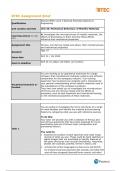Summary
Summary Unit 25 - Mechanical Behaviours of Metallic Materials Assignment 1 - Distinction Grade
- Course
- Institution
- Book
Unit 25 - Mechanical Behaviours of Metallic Materials Assignment 1 - Distinction Grade includes all the necessary details that are stated in the assignment brief. I can reassure you that this is a distinction grade assignment. However, if you are in doubt just send me a message anytime. Thank you
[Show more]




